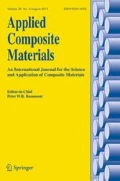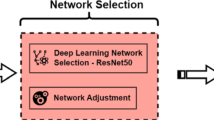Abstract
This paper proposed a method for predicting composite laminates’ compressive residual strength after impact based on convolutional neural networks. Laminates made by M21E/IMA prepreg were used to introduce low-velocity impact damage and construct a non-destructive testing image dataset. The dataset images characterized the impact damage details, including dents, delamination, and matrix cracking. The convolution kernel automatically extracted and identified these complex features that could be used for classification. The model took the images as input and compressive residual strength labels as output for iterative training, and the final prediction accuracy reached more than 90%, the highest 96%. This method introduced overall damage into the model in the form of images utilizing convolution, which can quickly and accurately predicted laminates’ compression performance after impact.














Similar content being viewed by others
Data Availability
The data that support the findings of this study are available from the corresponding author upon reasonable request.
References
Talreja, R., Phan, N.: Assessment of damage tolerance approaches for composite aircraft with focus on barely visible impact damage. Compos. Struct. 219, 1–7 (2019). https://doi.org/10.1016/j.compstruct.2019.03.052
Shah, S.Z.H., Karuppanan, S., Megat-Yusoff, P.S.M., Sajid, Z.: Impact resistance and damage tolerance of fiber reinforced composites: A review. Compos. Struct. 217, 100–121 (2019). https://doi.org/10.1016/j.compstruct.2019.03.021
Rhead, A.T., Butler, R., Baker, N.: Analysis and Compression Testing of Laminates Optimised for Damage Tolerance. Appl. Compos. Mater. 18, 85–100 (2011). https://doi.org/10.1007/s10443-010-9153-z
Polimeno, U., Meo, M., Almond, D.P., Angioni, S.L.: Detecting Low Velocity Impact Damage in Composite Plate Using Nonlinear Acoustic/Ultrasound Methods. Appl. Compos. Mater. 17, 481–488 (2010). https://doi.org/10.1007/s10443-010-9168-5
Meo, M., Polimeno, U., Zumpano, G.: Detecting Damage in Composite Material Using Nonlinear Elastic Wave Spectroscopy Methods. Appl. Compos. Mater. 15, 115–126 (2008). https://doi.org/10.1007/s10443-008-9061-7
Sun, W., Guan, Z., Li, Z.: Simulation of Low Velocity Impact Induced Inter- and Intra-Laminar Damage of Composite Beams Based on XFEM. Appl. Compos. Mater. 24, 1459–1477 (2017). https://doi.org/10.1007/s10443-017-9598-4
Ji, Z., Guan, Z., Li, Z.: A Progressive Damage Model for Predicting Permanent Indentation and Impact Damage in Composite Laminates. Appl. Compos. Mater. 24, 1029–1048 (2017). https://doi.org/10.1007/s10443-016-9572-6
Tan, R., Xu, J., Sun, W., Liu, Z., Guan, Z., Guo, X.: Relationship Between Matrix Cracking and Delamination in CFRP Cross-Ply Laminates Subjected to Low Velocity Impact. Materials. 12, 3990 (2019). https://doi.org/10.3390/ma12233990
Ouyang, T., Bao, R., Sun, W., Guan, Z., Tan, R.: A fast and efficient numerical prediction of compression after impact (CAI) strength of composite laminates and structures. Thin-Walled Struct. 148, 106588 (2020). https://doi.org/10.1016/j.tws.2019.106588
He, W., Guan, Z., Li, X., Liu, D.: Prediction of permanent indentation due to impact on laminated composites based on an elasto-plastic model incorporating fiber failure. Compos. Struct. 96, 232–242 (2013). https://doi.org/10.1016/j.compstruct.2012.08.054
Aoki, Y., Suemasu, H., Ishikawa, T.: Damage propagation in CFRP laminates subjected to low velocity impact and static indentation. Adv. Compos. Mater. 16, 45–61 (2007). https://doi.org/10.1163/156855107779755318
Topac, O.T., Gozluklu, B., Gurses, E., Coker, D.: Experimental and computational study of the damage process in CFRP composite beams under low-velocity impact. Compos. Pt. A-Appl. Sci. Manuf. 92, 167–182 (2017). https://doi.org/10.1016/j.compositesa.2016.06.023
Hyung Yun Choi, Chang, F.K.: A Model for Predicting Damage in Graphite/Epoxy Laminated Composites Resulting from Low-Velocity Point Impact. J. Compos. Mater. 26, 2134–2169 (1992). https://doi.org/10.1177/002199839202601408
Yang, L., Wu, Z., Gao, D., Liu, X.: Microscopic damage mechanisms of fibre reinforced composite laminates subjected to low velocity impact. Comput. Mater. Sci. 111, 148–156 (2016). https://doi.org/10.1016/j.commatsci.2015.09.039
Ding, J.C., Xu, W.: Determination of mode I interlaminar fracture toughness of composite by a wedge-insert double cantilever beam and the nonlinear J integral. Compos. Sci. Technol. 206, 108674 (2021). https://doi.org/10.1016/j.compscitech.2021.108674
Bouvet, C., Rivallant, S., Barrau, J.J.: Low velocity impact modeling in composite laminates capturing permanent indentation. Compos. Sci. Technol. 72, 1977–1988 (2012). https://doi.org/10.1016/j.compscitech.2012.08.019
Hongkarnjanakul, N., Bouvet, C., Rivallant, S.: Validation of low velocity impact modelling on different stacking sequences of CFRP laminates and influence of fibre failure. Compos. Struct. 106, 549–559 (2013). https://doi.org/10.1016/j.compstruct.2013.07.008
Bull, D.J., Spearing, S.M., Sinclair, I.: Investigation of the response to low velocity impact and quasi-static indentation loading of particle-toughened carbon-fibre composite materials. Compos. Pt. A-Appl. Sci. Manuf. 74, 38–46 (2015). https://doi.org/10.1016/j.compositesa.2015.03.016
Sztefek, P., Olsson, R.: Tensile stiffness distribution in impacted composite laminates determined by an inverse method. Compos. Pt. A-Appl. Sci. Manuf. 39, 1282–1293 (2008). https://doi.org/10.1016/j.compositesa.2007.10.005
Sztefek, P., Olsson, R.: Nonlinear compressive stiffness in impacted composite laminates determined by an inverse method. Compos. Pt. A-Appl. Sci. Manuf. 40, 260–272 (2009). https://doi.org/10.1016/j.compositesa.2008.12.002
Craven, R., Sztefek, P., Olsson, R.: Investigation of impact damage in multi-directional tape laminates and its effect on local tensile stiffness. Compos. Sci. Technol. 68, 2518–2525 (2008). https://doi.org/10.1016/j.compscitech.2008.05.008
Suemasu, H., Ichiki, M.: Analytical study on low compressive strength of composite laminates with impact damage. Compos. Struct. 104, 169–175 (2013). https://doi.org/10.1016/j.compstruct.2013.04.017
Nyman, T., Bredberg, A., Schon, J.: Equivalent Damage and Residual Strength for Impact Damaged Composite Structures. J. Reinf. Plast. Compos. 19(6), 428–448 (2000). https://doi.org/10.1177/073168440001900601
Romano, F., Di Caprio, F., Mercurio, U.: Compression after Impact Analysis of Composite Panels and Equivalent Hole Method. Procedia Engineering. 167, 182–189 (2016). https://doi.org/10.1016/j.proeng.2016.11.686
Puhui, C., Zhen, S., Junyang, W.: A New Method for Compression After Impact Strength Prediction of Composite Laminates. J. Compos Mater. 36, 589–610 (2002). https://doi.org/10.1177/0021998302036005497
Tan, W., Falzon, B.G., Chiu, L.N.S., Price, M.: Predicting low velocity impact damage and Compression-After-Impact (CAI) behaviour of composite laminates. Compos. Pt. A-Appl. Sci. Manuf. 71, 212–226 (2015). https://doi.org/10.1016/j.compositesa.2015.01.025
Maio, L., Monaco, E., Ricci, F., Lecce, L.: Simulation of low velocity impact on composite laminates with progressive failure analysis. Compos. Struct. 103, 75–85 (2013). https://doi.org/10.1016/j.compstruct.2013.02.027
Horton, P.E., Whitehead, R.: Damage Tolerance of Composites, Vol. I and II, Air Force Wright Aeronautical Laboratories, AFWAL TR 87, 3030 (1988)
Hosur, M.V., Murthy, C., Ramurthy, T.S.: Compression after impact testing of carbon fiber reinforced plastic laminates. J. Compos. Tech. Res. 21(2), 51–64 (1999)
LeCun, Y., Bengio, Y., Hinton, G.: Deep learning. Nature 521, 436–444 (2015). https://doi.org/10.1038/nature14539
Fukushima, K.: Neocognitron: A self-organizing neural network model for a mechanism of pattern recognition unaffected by shift in position. Biol. Cybernetics. 36, 193–202 (1980). https://doi.org/10.1007/BF00344251
LeCun, Y. and Bengio, Y.: Convolutional Networks for Images, Speech, and Time-Series. In: Arbib, M.A., Eds., The Handbook of Brain Theory and Neural Networks, MIT Press, Cambridge (1995)
Krizhevsky, A., Sutskever, I., Hinton, G.E.: ImageNet classification with deep convolutional neural networks. Commun. ACM. 60, 84–90 (2012).https://doi.org/10.1145/3065386
Simonyan, K., Zisserman, A.: Very Deep Convolutional Networks for Large-Scale Image Recognition. arXiv:1409.1556 [cs]. (2015)
Szegedy, C., Liu, W., Jia, Y., Sermanet, P., Reed, S., Anguelov, D., Erhan, D., Vanhoucke, V., Rabinovich, A.: Going Deeper with Convolutions. arXiv:1409.4842 [cs]. (2014)
Ioffe, S., Szegedy, C.: Batch Normalization: Accelerating Deep Network Training by Reducing Internal Covariate Shift. arXiv:1502.03167 [cs]. (2015)
Szegedy, C., Vanhoucke, V., Ioffe, S., Shlens, J., Wojna, Z.: Rethinking the Inception Architecture for Computer Vision. arXiv:1512.00567 [cs]. (2015)
Szegedy, C., Ioffe, S., Vanhoucke, V., Alemi, A.: Inception-v4, Inception-ResNet and the Impact of Residual Connections on Learning. arXiv:1602.07261 [cs]. (2016)
He, K., Zhang, X., Ren, S., Sun, J.: Deep Residual Learning for Image Recognition. arXiv:1512.03385 [cs]. (2015)
Huang, G., Liu, Z., Van Der Maaten, L., Weinberger, K.Q.: Densely Connected Convolutional Networks. In: 2017 IEEE Conference on Computer Vision and Pattern Recognition (CVPR). pp. 2261–2269. IEEE, Honolulu, HI (2017)
Hu, J., Shen, L., Albanie, S., Sun, G., Wu, E.: Squeeze-and-Excitation Networks. arXiv:1709.01507 [cs]. (2019)
Agrawal, A., Choudhary, A.: Perspective: Materials informatics and big data: Realization of the “fourth paradigm” of science in materials science. APL Mater. 4(5), 053208 (2016)
Li, D., Li, Y., Zhou, J., Zhao, Z.: A Novel Method to Improve Temperature Uniformity in Polymer Composites Microwave Curing Process through Deep Learning with Historical Data. Appl. Compos. Mater. 27, 1–17 (2020). https://doi.org/10.1007/s10443-019-09791-5
Erkan, Ö., Işık, B., Çiçek, A., Kara, F.: Prediction of Damage Factor in end Milling of Glass Fibre Reinforced Plastic Composites Using Artificial Neural Network. Appl. Compos. Mater. 20, 517–536 (2013). https://doi.org/10.1007/s10443-012-9286-3
Yang, C., Kim, Y., Ryu, S., Gu, G.X.: Prediction of composite microstructure stress-strain curves using convolutional neural networks. Mater. Des. 189, 108509 (2020). https://doi.org/10.1016/j.matdes.2020.108509
Nasiri, M.R., Mahjoob, M.J., Aghakasiri, A.: Damage Detection in a Composite Plate Using Modal Analysis and Artificial Intelligence. Appl. Compos. Mater. 18, 513–520 (2011). https://doi.org/10.1007/s10443-011-9231-x
Xu, D., Liu, P.F., Li, J.G., Chen, Z.P.: Damage mode identification of adhesive composite joints under hygrothermal environment using acoustic emission and machine learning. Compos. Struct. 211, 351–363 (2019). https://doi.org/10.1016/j.compstruct.2018.12.051
Zenzen, R., Khatir, S., Belaidi, I., Le Thanh, C., Abdel Wahab, M.: A modified transmissibility indicator and Artificial Neural Network for damage identification and quantification in laminated composite structures. Compos. Struct. 248, 112497 (2020). https://doi.org/10.1016/j.compstruct.2020.112497
Abueidda, D.W., Almasri, M., Ammourah, R., Ravaioli, U., Jasiuk, I.M., Sobh, N.A.: Prediction and optimization of mechanical properties of composites using convolutional neural networks. Compos. Struct. 227, 111264 (2019). https://doi.org/10.1016/j.compstruct.2019.111264
Rong, Q., Wei, H., Huang, X., Bao, H.: Predicting the effective thermal conductivity of composites from cross sections images using deep learning methods. Compos. Sci. Technol. 184, 107861 (2019). https://doi.org/10.1016/j.compscitech.2019.107861
Bang, H.T., Park, S., Jeon, H.: Defect identification in composite materials via thermography and deep learning techniques. Compos. Struct. 246, 112405 (2020). https://doi.org/10.1016/j.compstruct.2020.112405
Califano, A.: Damage Detection in Composites by Artificial Neural Networks Trained by Using in Situ Distributed Strains. Appl. Compos. Mater. 27, 657–671 (2020).https://doi.org/10.1007/s10443-020-09829-z
Ripley, B.D.: Pattern recognition and neural networks. Cambridge University Press, Cambridge, New York (1996)
Heaton, J.: Ian Goodfellow, Yoshua Bengio, and Aaron Courville: Deep learning. Genet Program Evolvable Mach. 19, 305–307 (2018). https://doi.org/10.1007/s10710-017-9314-z
Yarotsky, D.: Error bounds for approximations with deep ReLU networks. Neural Netw. 94, 103–114 (2017)
Boureau, Y.L., Bach, F., LeCun, Y., Ponce, J.: Learning mid-level features for recognition. In: 2010 IEEE Computer Society Conference on Computer Vision and Pattern Recognition. pp. 2559–2566. IEEE, San Francisco, CA, USA (2010)
Khosravani, M.R.: Composite Materials Manufacturing Processes. AMM. 110(116), 1361–1367 (2011). https://doi.org/10.4028/www.scientific.net/AMM.110-116.1361
Narnhofer, M., Schledjewski, R., Mitschang, P., Perko, L.: Simulation of the Tape-Laying Process for Thermoplastic Matrix Composites. Adv. Polym. Technol. 32, E705–E713 (2013). https://doi.org/10.1002/adv.21312
ASTM D7136/D7136M-12: Standard Test Method for Measuring the Damage Resistance of a Fiber-Reinforced Polymer Matrix Composite to a Drop-Weight Impact Event, ASTM International, West Conshohocken, PA, 19428–2959, USA (2012)
SAE International: CMH-17 Composite Materials Handbook volume 3. polymer matrix composites mate-rials usage, design, and analysis. Warrendale, PA, USA (2012)
ASTM D7137/D7137M-12: Standard Test Method for Compressive Residual Strength Properties of Damaged Polymer Matrix Composite Plates, ASTM International, West Conshohocken, PA, 19428–2959, USA (2012).
Aymerich, F., Dore, F., Priolo, P.: Simulation of multiple delaminations in impacted cross-ply laminates using a finite element model based on cohesive interface elements. Composi. Sci. Technol. 69, 1699–1709 (2009). https://doi.org/10.1016/j.compscitech.2008.10.025
Fawcett, T.: An introduction to ROC analysis. Pattern Recogn. Lett. 27, 861–874 (2006). https://doi.org/10.1016/j.patrec.2005.10.010
Author information
Authors and Affiliations
Corresponding author
Additional information
Publisher's Note
Springer Nature remains neutral with regard to jurisdictional claims in published maps and institutional affiliations.
Rights and permissions
About this article
Cite this article
Jiang, F., Guan, Z., Wang, X. et al. Study on Prediction of Compression Performance of Composite Laminates After Impact Based on Convolutional Neural Networks. Appl Compos Mater 28, 1153–1173 (2021). https://doi.org/10.1007/s10443-021-09904-z
Received:
Accepted:
Published:
Issue Date:
DOI: https://doi.org/10.1007/s10443-021-09904-z




